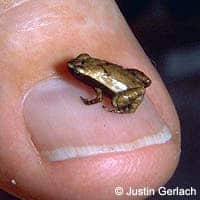One of the smallest amphibians in the world, the Gardiner’s Seychelles frog, is also one of the most eccentric. The frog doesn’t stand out through an over-glamorous coloring or some unique, wild mating call, but rather as a result of one of its weird biological features. This frog doesn’t have ears – yet it can hear. How? By receiving sound waves through its mouth.

Talk with your ears, listen with your mouth
The mystery deepened even further after the scientists had the frogs X-rayed and saw that their bones didn’t conduct sound, like human jawbones do for instance. So scientists made a wild guess: what if the frog could hear through its mouth by directing sound to its inner ear – a cavity within the frog’s skull that hosts reverberated noises?They performed a simulation and, indeed, it showed that the frog was indeed capable of hearing through this method. This doesn’t mean it hears in this manner though – it just demonstrates that it could.
The Seychelles frog can only be found on a few islands in the Seychelles, off the coast of Madagascar. Scientists suspect that due to its isolation, the species’ hearing has evolved very little. Advanced hearing, characterized by the evolution of eardrums, dates back from the time of the separation of Gondwana, an ancient supercontinent. Studying Sechelles frogs, researchers hope not only to unravel how this peculiar animal performs basic biological functions, but also how Gondwana animals might had looked and behaved like.
via PopSci






